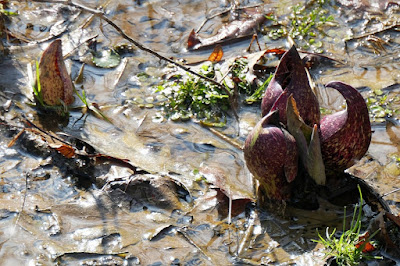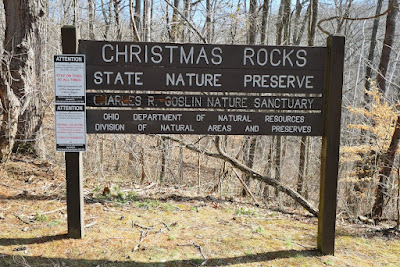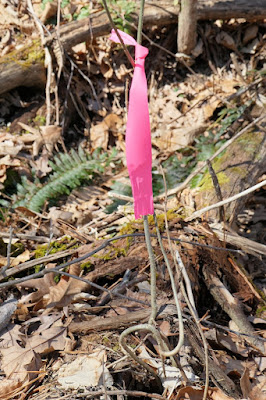On March 2nd Joan and I took advantage of a rare pleasant winter day -- sunny but not too cold -- to revisit Christmas Rocks State Nature Preserve, about the same time as last year (March 10th). We weren't looking for a strenuous hike, but there was still plenty to see.
The first stretch from the parking lot is a gravel road, a driveway to an inholding in the Preserve.
Our first fallen tree, of which we saw many, was on that road before the inhold property and house. How would you like to head out in the morning and see a tree this thick across your drive?
We were hopeful that we would see some skunk cabbage, a thermogenic plant, one that can generate heat and emerge from frozen or snow-covered ground. At first there weren't any, but then Joan and I came across some good patches.Most of them haven't opened yet, but I have a good picture from last year's visit here.
Last March we had also heard and seen wood frogs courting and mating in the transient pools here, but this chilly morning there was no such activity.
 |
| The pale green is the inholding. |
 |
| Looking back to the parking. |
Last March we had also heard and seen wood frogs courting and mating in the transient pools here, but this chilly morning there was no such activity.
There's an entrance sign where the road switches from wide and graveled to a narrow, unmaintained surface, busy reverting from an old farm road to a hiking path.Joan and I prefer to take the orange loop clockwise, tackling the steepest part in the preserve going uphill rather than down. With the leaves off the trees, we could see the bluff as we approached the intersection.
No greenery had yet emerged along the trail. This photo takes a closer look at the southwest flank of the bluff known as Jacob's Ladder, before the now-narrow trail takes a sharp jog to the right. We were glad for our hiking poles on this stretch.
The view from the top, here at the beginnings of the Appalachian region.
After a brief stretch on top the path heads downhill, back to the old road. Joan and I chose to continue on the road, to take the blue loop counter-clockwise. We encountered our second hiker of the day at the spot where it crossed Arney Run. She was sitting on a flat rock on the edge of the stream, talking to someone on her phone. We did not interrupt, and continued; she never knew we had been there.
 |
| Photo taken just after starting the loop. Not steep yet. |
The view from the top, here at the beginnings of the Appalachian region.
After a brief stretch on top the path heads downhill, back to the old road. Joan and I chose to continue on the road, to take the blue loop counter-clockwise. We encountered our second hiker of the day at the spot where it crossed Arney Run. She was sitting on a flat rock on the edge of the stream, talking to someone on her phone. We did not interrupt, and continued; she never knew we had been there.
The blue loop traverses several ecological zones. Soon after the climb up the side valley began, we entered an extensive stand of pines and other evergreens. Browned needles covered the forest floor. As the valley narrowed, it reverted to an open woodland, and as we advanced, the bowl-shaped end of the valley appeared.As you can see on the map, the trail rises gradually as it follows the ridge to the right, and then surfaces at the ridgeline as it turns back. Along the way, we spotted this tree, broken by a windstorm, with "feathers" sticking out from the top.At our favorite sitting log, a dozen yards back in the woods, we snacked and had a pit stop. On the north side of the ridge, some well-shaded ice still lingered.Nature intertwined roots, rocks, and moss with sporophyte bodies at this spot on the descent.Back on the road, traversing the orange section we hadn't yet trod, another tree had recently fallen across the road.On closer inspection, we were intrigued by the flies attracted to the oozing sap from this fresh fall.Nearby, this plant had been marked as important -- for some reason unknown to us.By this time, one-thirty-ish, the bright sun had raised the temperature to near 60°F, and the wood frogs had come out! The pools were lower than last year, and the vegetation hampered my photography, but with binoculars we could spot a few as well as hear them. What a delight!
This is a clever if fraught strategy on the part of the frogs. Laying their eggs in an ephemeral pool -- one which will dry out later in the year -- means there are no fish present to predate on the eggs. However, if the pool dries out too early ... In any case, once the eggs are laid the frogs return to their woodland habitat. Child care is not an issue.
We'll be sure to return later in the spring for flower spotting, which was gorgeous last year.













No comments:
Post a Comment
Comments may not appear immediately as they are moderated by the author to eliminate spam. Please, no commercial links!